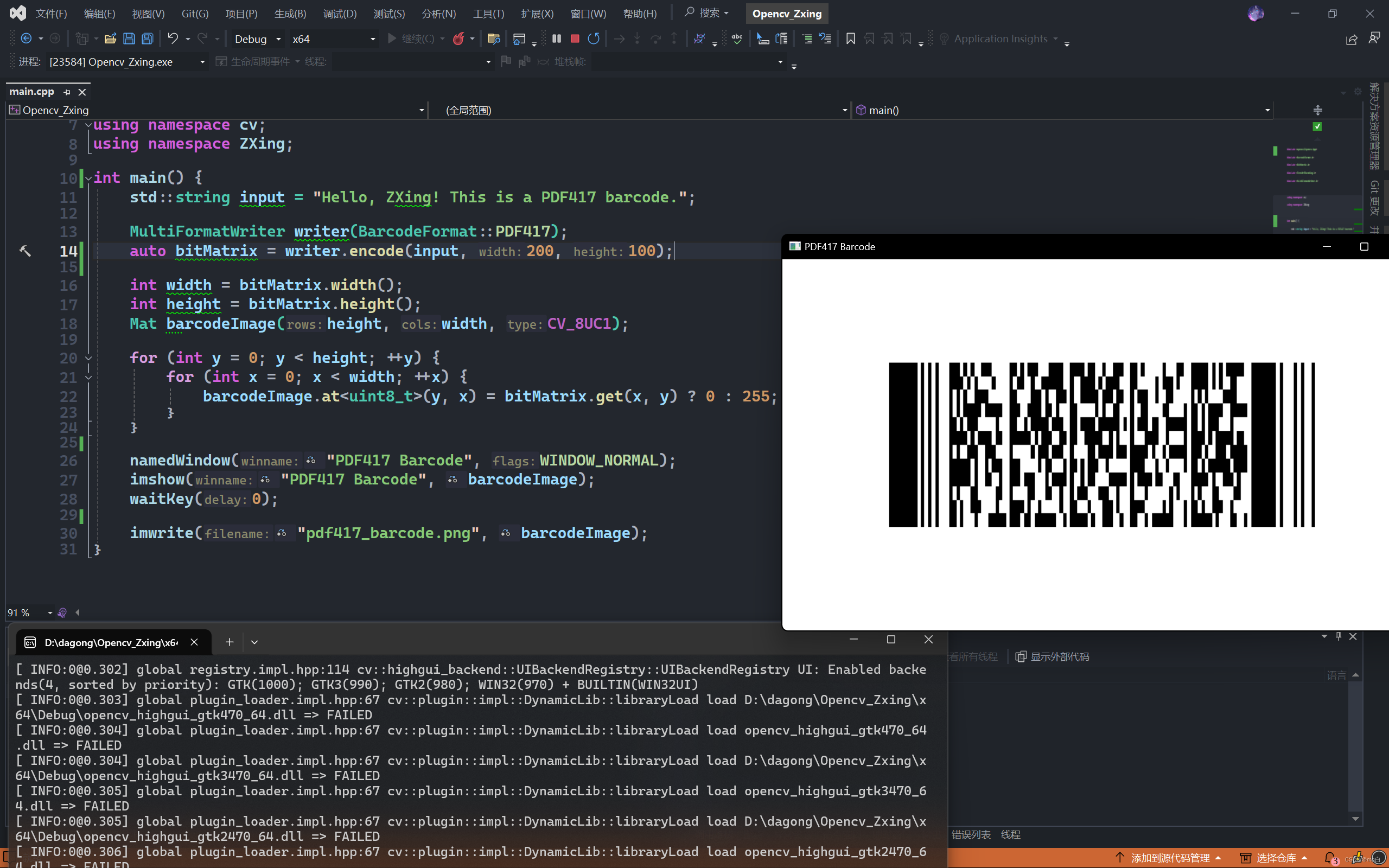编译构建
需要使用到 CMake、Git、GCC 或 MSVC。
github 链接:https://github.com/zxing-cpp/zxing-cpp
编译之前请确保:
-
确保安装了 CMake 版本 3.15 或更高版本。
-
确保安装了与 C++17 兼容的编译器(最低VS 2019 16.8 / gcc 7 / clang 5)。
编译构建很简单,如同官网:
txt
git clone https://github.com/zxing-cpp/zxing-cpp.git --recursive --single-branch --depth 1
cmake -S zxing-cpp -B zxing-cpp.release -DCMAKE_BUILD_TYPE=Release
cmake --build zxing-cpp.release -j8 --config Release如果出错那就只能自行解决,不过不用担心,我们已经提供了编译完成的静态库。
此库不支持动态库,我们提供了 debug 和 release 两种 .lib。
之后就是正常的引入静态库的环境配置了,不再介绍。
OpenCV
ZXing 理论上不依赖 OpenCV 等其它库,不过涉及图形操作,我们的第一选择基本也就是 OpenCV 了。实测 OpenCV3 与 OpenCV4 都可使用。
OpenCV + Zxing 根据字符串生成 PDF417 条形码
cpp
#include <opencv2/opencv.hpp>
#include <BarcodeFormat.h>
#include <BitMatrix.h>
#include <TextUtfEncoding.h>
#include <MultiFormatWriter.h>
using namespace cv;
using namespace ZXing;
int main() {
std::string input = "Hello, ZXing! This is a PDF417 barcode.";
MultiFormatWriter writer(BarcodeFormat::PDF417);
auto bitMatrix = writer.encode(input, 200, 100);
int width = bitMatrix.width();
int height = bitMatrix.height();
Mat barcodeImage(height, width, CV_8UC1);
for (int y = 0; y < height; ++y) {
for (int x = 0; x < width; ++x) {
barcodeImage.at<uint8_t>(y, x) = bitMatrix.get(x, y) ? 0 : 255;
}
}
namedWindow("PDF417 Barcode", WINDOW_NORMAL);
imshow("PDF417 Barcode", barcodeImage);
waitKey(0);
imwrite("pdf417_barcode.png", barcodeImage);
}
实测扫码枪可以识别。如果当前环境编码存在问题,可以考虑进行编码转换,转换到 UTF-8。
我们稍微详细的来解释一下上面的代码。
- 包含头文件:
- 包含 OpenCV 和 ZXing 库的头文件。以及引入对应的命名空间
cpp
#include <opencv2/opencv.hpp>
#include <BarcodeFormat.h>
#include <BitMatrix.h>
#include <TextUtfEncoding.h>
#include <MultiFormatWriter.h>
using namespace cv;
using namespace ZXing;-
输入字符串并生成 PDF417 条形码
-
定义一个要编码为 PDF417 条形码的字符串:
cppstd::string input = "Hello, ZXing! This is a PDF417 barcode."; -
生成 PDF417 条形码:
创建一个
MultiFormatWriter对象,指定条形码格式为PDF417。使用
encode方法将输入字符串编码为一个位矩阵(bit matrix),并指定图像的宽度和高度(200x100)。cppMultiFormatWriter writer(BarcodeFormat::PDF417); auto bitMatrix = writer.encode(input, 200, 100); // 宽度和高度可以根据需要调整
-
-
将条形码数据转换为 OpenCV Mat 对象:
-
获取位矩阵的宽度和高度。
-
创建一个 OpenCV 的灰度图像矩阵。
-
遍历位矩阵的每个像素点,如果为真则设为黑色(0),否则设为白色(255)
cppint width = bitMatrix.width(); int height = bitMatrix.height(); Mat barcodeImage(height, width, CV_8UC1); for (int y = 0; y < height; ++y) { for (int x = 0; x < width; ++x) { barcodeImage.at<uint8_t>(y, x) = bitMatrix.get(x, y) ? 0 : 255; } } -
-
显示条形码图像:
创建窗口并显示,等待用户按下任意键关闭窗口:
cppnamedWindow("PDF417 Barcode", WINDOW_NORMAL); imshow("PDF417 Barcode", barcodeImage); waitKey(0); -
保存条形码为本地图像:
cppimwrite("pdf417_barcode.png", barcodeImage);
总结
最大的问题不在于代码的理解,而是在于环境的构建。
代码本身是简单的,根据这个小例子足以修改、增加,完成许多的需求。